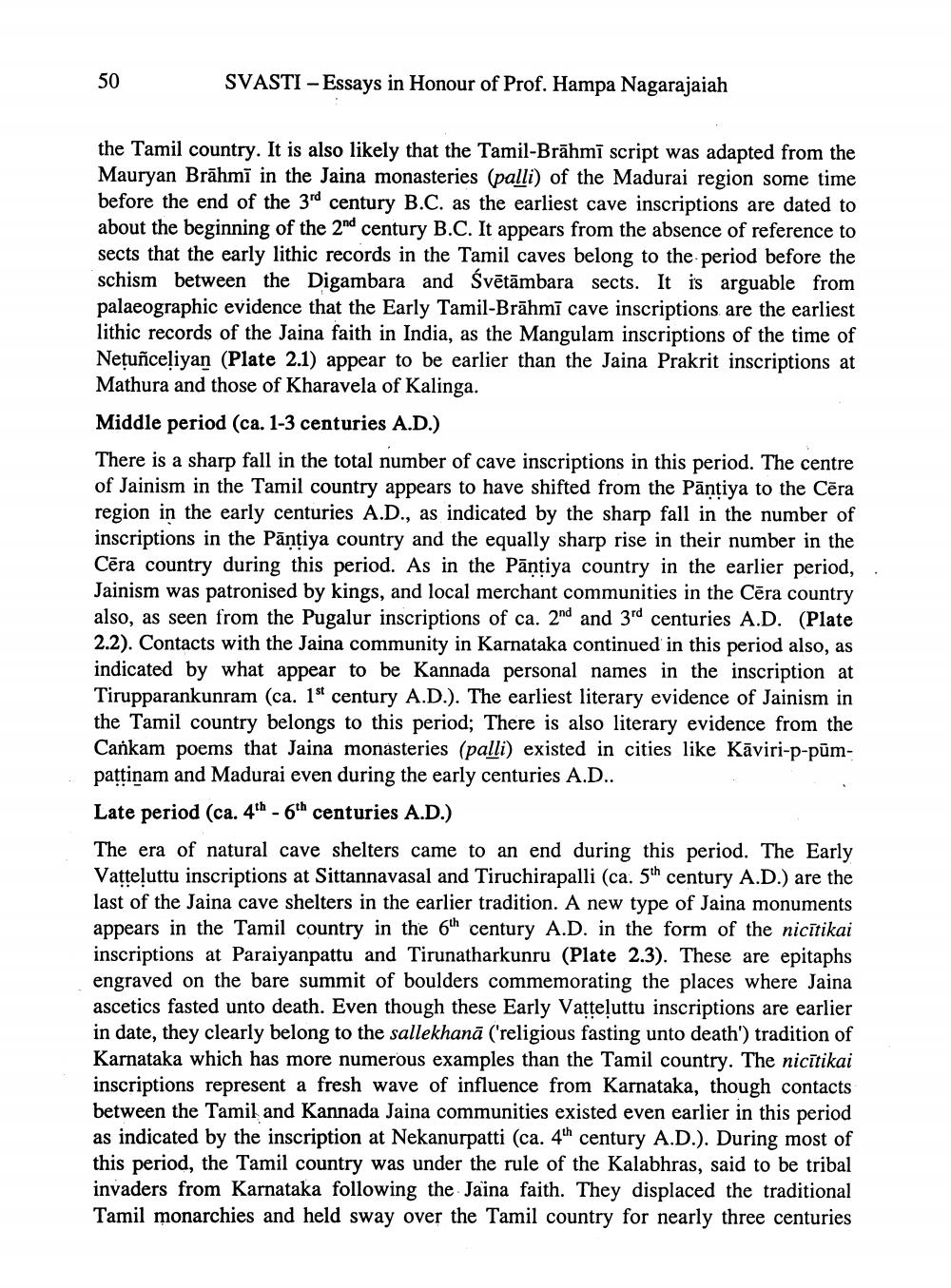________________
SVASTI -Essays in Honour of Prof. Hampa Nagarajaiah
the Tamil country. It is also likely that the Tamil-Brāhmī script was adapted from the Mauryan Brähmï in the Jaina monasteries (palli) of the Madurai region some time before the end of the 3d century B.C. as the earliest cave inscriptions are dated to about the beginning of the 2nd century B.C. It appears from the absence of reference to sects that the early lithic records in the Tamil caves belong to the period before the schism between the Digambara and Svētämbara sects. It is arguable from palaeographic evidence that the Early Tamil-Brähmi cave inscriptions are the earliest lithic records of the Jaina faith in India, as the Mangulam inscriptions of the time of Netunceliyan (Plate 2.1) appear to be earlier than the Jaina Prakrit inscriptions at Mathura and those of Kharavela of Kalinga.
50
Middle period (ca. 1-3 centuries A.D.)
There is a sharp fall in the total number of cave inscriptions in this period. The centre of Jainism in the Tamil country appears to have shifted from the Päntiya to the Cera region in the early centuries A.D., as indicated by the sharp fall in the number of inscriptions in the Pantiya country and the equally sharp rise in their number in the Cera country during this period. As in the Päntiya country in the earlier period, Jainism was patronised by kings, and local merchant communities in the Cera country also, as seen from the Pugalur inscriptions of ca. 2nd and 3rd centuries A.D. (Plate 2.2). Contacts with the Jaina community in Karnataka continued in this period also, as indicated by what appear to be Kannada personal names in the inscription at Tirupparankunram (ca. 1" century A.D.). The earliest literary evidence of Jainism in the Tamil country belongs to this period; There is also literary evidence from the Cankam poems that Jaina monasteries (palli) existed in cities like Kāviri-p-pumpattinam and Madurai even during the early centuries A.D..
Late period (ca. 4th - 6th centuries A.D.)
The era of natural cave shelters came to an end during this period. The Early Vatteluttu inscriptions at Sittannavasal and Tiruchirapalli (ca. 5th century A.D.) are the last of the Jaina cave shelters in the earlier tradition. A new type of Jaina monuments appears in the Tamil country in the 6th century A.D. in the form of the nicitikai inscriptions at Paraiyanpattu and Tirunatharkunru (Plate 2.3). These are epitaphs engraved on the bare summit of boulders commemorating the places where Jaina ascetics fasted unto death. Even though these Early Vatteluttu inscriptions are earlier in date, they clearly belong to the sallekhanā ('religious fasting unto death') tradition of Karnataka which has more numerous examples than the Tamil country. The nicîtikai inscriptions represent a fresh wave of influence from Karnataka, though contacts between the Tamil and Kannada Jaina communities existed even earlier in this period. as indicated by the inscription at Nekanurpatti (ca. 4th century A.D.). During most of this period, the Tamil country was under the rule of the Kalabhras, said to be tribal invaders from Karnataka following the Jaina faith. They displaced the traditional Tamil monarchies and held sway over the Tamil country for nearly three centuries




